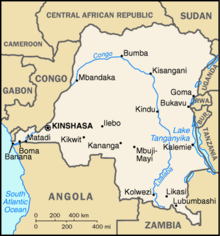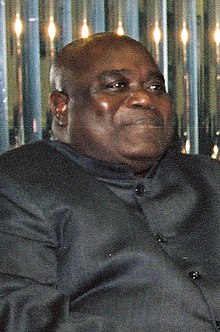First Congo War
AFDL victory Zaire Sudan[1] Chad[2] Ex-FAR/ALiR Interahamwe CNDD-FDD[3] UNITA[4] ADF[5] FLNC[6]Supported by: France[7][8] Central African Republic[8] China[9] Israel[9] Kuwait (denied)[9] AFDL Rwanda Uganda[13] Burundi[14] Angola[14] SPLA[1] Eritrea[15]Supported by: South Africa[16] Zambia[17] Zimbabwe[16] Ethiopia[18] Tanzania[19] United States (covertly)[20]
By 1996, Zaire was in a state of political and economic collapse, exacerbated by long-standing internal strife and the destabilizing effects of the 1994 Rwandan genocide, which had led to the influx of refugees and militant groups into the country.
[39] Following the end of the Cold War in 1992, the United States stopped supporting Mobutu in favor of what it called a "new generation of African leaders",[40] including Rwanda's Paul Kagame and Uganda's Yoweri Museveni.
He officially ended the one-party system he had maintained since 1967, but ultimately proved unwilling to implement broad reform, alienating allies both at home and abroad.
[43] Mobutu's rule encountered considerable internal resistance, and given the weak central state, rebel groups could find refuge in Zaire's eastern provinces, far from the capital, Kinshasa.
Opposition groups included leftists who had supported Patrice Lumumba (1925–1961), as well as ethnic and regional minorities opposed to the nominal dominance of Kinshasa.
[44] The inability of the Mobutuist régime to control rebel movements in its eastern provinces eventually allowed its internal and external foes to ally.
When colonial boundaries were drawn in the late nineteenth century many Banyarwanda found themselves on the Congolese side of the Rwandan border, in Kivu province.
[48] This move aggravated the existing ethnic tensions by strengthening the Banyamulenge's hold over important stretches of land in North Kivu that indigenous people claimed as their own.
[48] From 1963 to 1966 the Hunde and Nande ethnic groups of North Kivu fought against Rwandan emigrants[49] — both Tutsi and Hutu – in the Kanyarwanda War, which involved several massacres.
[54] Due to political exclusion and ethnic violence, as early as 1991 the Banyamulenge developed ties to the Rwandan Patriotic Front (RPF), a mainly Tutsi rebel movement based in Uganda but with aspirations to power in Rwanda.
[58] Furthermore, the newly arrived militants were intent on returning to power in Rwanda and began launching attacks against the new regime in Kigali, which represented a serious security threat to the infant state.
[59] Not only was the Mobutu government incapable of controlling the former génocidaires for previously mentioned reasons but actually supported them in training and supplying for an invasion of Rwanda,[60] forcing Kigali to act.
Given the exacerbated ethnic tensions and the lack of government control in the past, Rwanda took action against the security threat posed by génocidaires who had found refuge in eastern Zaire.
[61] The initial goal of the Banyamulenge Rebellion was to seize power in Zaire's eastern Kivu provinces and combat the extremist Hutu forces attempting to continue the genocide in their new home.
Observers of the war, as well as the Rwandan Defense Minister and vice-president at the time, Paul Kagame, claim that the AFDL was formed in and directed from Kigali and contained not only Rwandan-trained troops but also regulars of the RPA.
While its actions were originally sparked by the security threat posed by the Zairian-based génocidaires, Kigali was pursuing multiple goals during its invasion of Zaire.
Kagame claimed that Rwandan agents had discovered the plans to invade Rwanda with support from Mobutu; in response, Kigali began its intervention with the intention of dismantling the refugee camps in which the génocidaires often took refuge and destroying the structure of these anti-Rwandan elements.
The Angolan government chose to act primarily through the original-Katanga Gendarmeries later called the Tigres, proxy groups formed from the remnants of police units exiled from Congo in the 1960s, fighting to return to their homeland.
Angola chose to participate in the First Congo War because members of Mobutu's government were directly involved in supplying the Angolan rebel group, UNITA.
Regardless of the reasoning in Kinshasa, Angola entered the war on the side of the rebels and was determined to overthrow the Mobutu government, which it saw as the only way to address the threat posed by the Zairian-UNITA relationship.
[2] France also provided Mobutu's government with financial support and military aid, facilitated by the Central African Republic, and diplomatically advocated for international intervention to stop the AFDL's advance, but later backed down due to U.S.
[66] The true extent of the abuses is unknown because the AFDL and RPF carefully managed NGO and press access to areas where atrocities were thought to have occurred.
[86] [verification needed]The United Nations similarly documented mass killings of civilians by Rwandan, Ugandan and the AFDL soldiers in the DRC Mapping Exercise Report.
The government denied the rebels' success, starting a long pattern of false statements from the Defense Minister on the progress and conduct of the war.
[87] Kabila, by this point in control of roughly one-quarter of the country, dismissed this as irrelevant and warned Tshisekedi that he would have no part in a new government if he accepted the post.There are two explanations for the restart of the rebel advance in 1997.
The first, and most probable, is that Angola had joined the anti-Mobutu coalition, giving it numbers and strength far superior to the FAZ, and demanding that Mobutu be removed from power.
Kagame presents another, possibly secondary, reason for the march on Kinshasa: that the employment of Serbian mercenaries in the battle for Walikale proved that "Mobutu intended to wage real war against Rwanda.
"[88] According to this logic, Rwanda's initial concerns had been to manage the security threat in eastern Zaire but it was now forced to dispose of the hostile government in Kinshasa.
However, the AFDL did not take these negotiations seriously but instead partook so as to avoid international criticism for being unwilling to attempt a diplomatic solution while actually continuing its steady advance.



